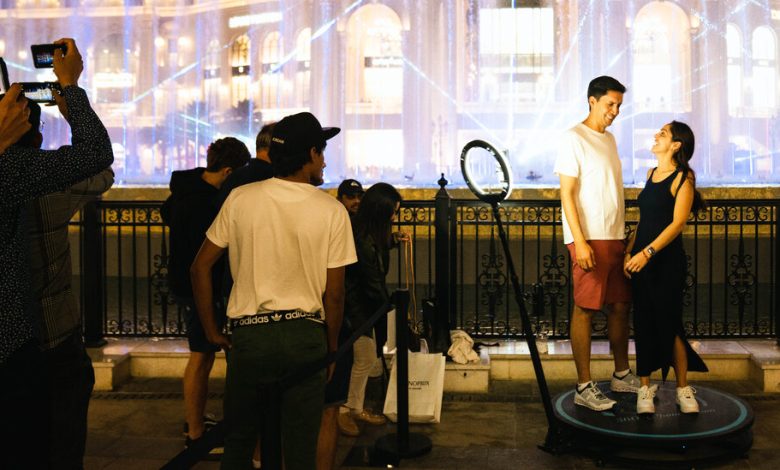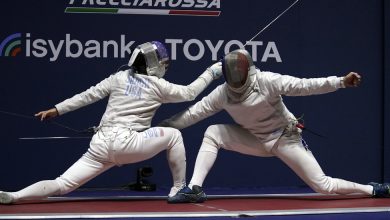When World Cup Reality Isn’t What It Seems

LUSAIL, Qatar — Fatih pulls the car over, letting the engine idle, and reaches for his phone. He hurriedly swipes away the various ride-sharing apps he has open and scrolls through his WhatsApp chats with a practiced finger. He is searching for a group called “Brazil Fans Qatar.” This, he says, will explain everything.
Last month, as teams started to arrive in Qatar ahead of the World Cup, several found guards of honor waiting for them at their hotels and training bases: groups of a few dozen fans, clad in national-team jerseys, waving national flags, carrying homemade banners and beating drums.
In most circumstances, that would not be especially noteworthy. Here, though, it was impossible not to wonder.
There had long been doubts about how many fans would attend the first World Cup in the Middle East, thanks to both practical concerns — the cost of spending weeks in Doha, the relative scarcity of alcohol — and ethical ones, centered on Qatar’s treatment of the migrant workers who had built the tournament, and its criminalization of homosexuality.
Qatar, it had already emerged, had recruited several hundred “fan leaders” from across the world, paying for their flights and accommodations in exchange for their enthusiastic, public support. The suspicion ran that the groups waiting to welcome the teams, apparently wholly composed of South Asian men, were another arm of the same program.
No, no, no, Fatih said, suddenly stopping the car. He is ordinarily “an accountant and a sales executive,” he said, but for the duration of the tournament he has set up — with permission — as a taxi service, too. Like most foreign workers here, he preferred not to use his last name out of fear of drawing unwanted attention from the country’s authorities.
After a minute or so, he finds what he wants: a video from Kerala, his home state in India. It had been shot that day but had already been forwarded many times. It showed two groups of men, some carrying sticks, brawling in the center of a village. Half of them are wearing bright yellow Brazil jerseys. The others are in the distinctive sky blue and white of Argentina.

Fireworks and a full house before the United States played Iran.Credit…Erin Schaff/The New York Times
“This happens every FIFA World Cup,” Fatih said. There are other fans whose loyalties lie with Portugal, or England, or Spain, he explained, but mostly it is Brazil and Argentina. The affiliations run deep. Fatih might change his club team, he said, but Brazil was nonnegotiable.
It was fans like these, like him, who had greeted the teams in Doha: Keralans who live and work in Qatar and had been sufficiently enthused by the prospect of seeing these usually remote, distant stars in the flesh that many of them paid hundreds of dollars for tickets to games. Fatih himself was going to see Brazil play Cameroon, he said. Any cost was worth it.
A Brief Guide to the 2022 World Cup
What is the World Cup? The quadrennial event pits the best national soccer teams against each other for the title of world champion. Here’s a primer to the 2022 men’s tournament:
Where is it being held? This year’s host is Qatar, which in 2010 beat the United States and Japan to win the right to hold the tournament. Whether that was an honest competition remains in dispute.
When is it? The tournament opened on Nov. 20, when Qatar played Ecuador. Over the two weeks that follow, four games will be played on most days. The tournament ends with the final on Dec. 18.
Is a winter World Cup normal? No. The World Cup usually takes place in July. But in 2015, FIFA concluded that the summer temperatures in Qatar might have unpleasant consequences and agreed to move the tournament to the relatively bearable months of November and December.
How many teams are competing? Thirty-two. Qatar qualified automatically as the host, and after years of matches, the other 31 teams earned the right to come and play. Meet the teams here.
How does the tournament work? The 32 teams are divided into eight groups of four. In the opening stage, each team plays all the other teams in its group once. The top two finishers in each group advance to the round of 16. After that, the World Cup is a straight knockout tournament.
How can I watch the World Cup in the U.S.? The tournament will be broadcast on Fox and FS1 in English, and on Telemundo in Spanish. You can livestream it on Peacock, or on streaming services that carry Fox and FS1. Here’s how to watch every match.
When will the games take place? Qatar is three hours ahead of London, eight hours ahead of New York and 11 hours ahead of Los Angeles. That means there will be predawn kickoffs on the East Coast of the United States for some games, and midafternoon starts for 10 p.m. games in Qatar.
Got more questions? We’ve got more answers here.
This World Cup, more than any other, has blurred the line between the organic and the ersatz, the artificial and the authentic. Those Keralan fans, it turned out, were among the few things about which it was possible to be absolutely certain, an island of vivid reality in a sea of the synthetic.
A Potemkin Vibe
The visual aesthetic of the World Cup is eternal, and uniform. Whether it is staged in Brazil or Russia or a tiny, thumb-shaped peninsula in the Gulf, its appearance is basically the same. The stadiums are sandblasted with FIFA’s insignia. There are advertisements for Budweiser and Hisense; inspiring, empty slogans; volunteers in lurid jackets.
World Cups are, in effect, always held in FIFAland, a theme park and a simulacrum, the stage for a made-for-television spectacle in which the identity and traditions of the host country are — for the most part — reduced to nothing more than an opening ceremony, a few “cultural activations” and a little themed merchandise.
Qatar is that process taken to its logical, literal extreme. It is not just that a raft of new hotels and apartment blocks has been built in Doha, it is that whole neighborhoods have been constructed. Lusail, the city that will host the final on Sunday, has been built from scratch, conjured from the sands.
For a month, the whole place has been given over to the World Cup. Qatar closed its schools, shuttered its offices and set about building a painstakingly curated version of reality. It has given Doha the air of a film set, a city viewing itself through a selection of Instagram filters.
Whatever your preferred backdrop, it is available. On Doha’s Corniche, skirting the city’s bay, a jetty has been given over for fans to take photos of the West Bay skyline. There are four backdrops available to frame your picture: a vast hourglass, sponsored by Hublot; one sign reading “I Love Qatar” and another “Qatar 2022”; and, for the literalists, a picture frame.
If that does not suit, then there is West Bay itself, its soaring glass towers, monuments to a capitalism unbound by borders, constantly illuminated in the flags of the competing nations and occasionally lit by fireworks and drone shows. Or there is trendy Msheireb, the package-fresh downtown district that has supposedly been modeled on New York, its coffee bars and food trucks all decked out in a globalized style that the writer Kyle Chayka has labeled “AirSpace.”
The greatest manifestation, though, is Lusail itself, with its boulevard inspired by the Champs-Élysées and its vast advertising screens that project Neymar in a way that is normally reserved for an aging tyrant or a religious figure. It runs from the gleaming, golden bowl of the Lusail Iconic Stadium to a giant iridescent shark, suspended between four aluminum-clad skyscrapers, at the other. (The shark, obviously, proves Qatar’s love of nature.)
A couple of miles away is Lusail marina, home to a shopping mall based around a facsimile of Place Vendôme, and to the official hotel, the closest thing on Earth to a Stargate, a crab’s claw in steel and glass, reaching into the sky as if it were trying to tear down heaven. In between stand empty lots and construction work, a city for a future that is not yet ready.
Doha is not unique in this, of course; it is not the first place to blur the boundary between authentic and inauthentic. There are countless premium urban developments in the West — Hudson Yards in New York, Granary Square in London — that could also be accused of being derivative, intentional, inorganic.
Its scale, though, is such that its effect is profoundly uncanny in a way that its most obvious parallels, Las Vegas and Disney World’s Epcot, are not. Lusail is drenched, permanently, in music so loud and light so bright it is impossible to think. Uplifting, high-tempo pop drifts through the streets of Msheireb from hidden speakers, as if sung by ghosts. The city itself felt so much like a stage that it became hard not to look for — or find — actors.
At Qatar’s first game, a defeat to Ecuador, one end of Al Bayt Stadium — a beautiful, gargantuan rendition of a Bedouin tent, surrounded by pristine lawns in the middle of the desert — was filled by fans wearing burgundy T-shirts, their arms snaked with tattoos, chanting and cheering and dancing for the host nation.
They were, it turned out, hired hands, Lebanese ultras recruited by Qatar to provide a bedrock of support. They were fake, in the traditional sense of the word, but that is not how they saw themselves: Their passion for the country that had brought the World Cup to a Muslim nation, to an Arab nation, they said, was real.
Around them, at every game they attended, were great swathes of empty seats. The fears of sparse attendances, it seemed, had been realized. Except that they had not: Like clockwork, an announcement would be made claiming that not only was the stadium full, but it was fuller than previously thought possible. Lusail, described for years as having room for 80,000 people, contained more than 88,000 for its first game.
When pressed, the organizing committee said that there was a difference between official capacity and operational capacity. Overnight, FIFA hurriedly adjusted the size of each stadium on its website. Where the line between the real and the synthetic stood depended, it seemed, on where you wanted it to stand.
So Many Fences
More than anything else, over the past four weeks, Doha has been a city of fences. There are fences down the middle of roads. There are fences along pavements. There are miles of fences, twisting and turning outside stadiums, along the edges of parks, around the concrete expanses of fan zones, all of them placed to guide fans to where they are supposed to be.
And where the fences are not sufficient, there are people. There are people standing in luminescent vests at traffic lights and crosswalks, helping fans cross the road, people standing on the tram tracks in Msheireb, helping fans to notice the tram, people every five yards or so in Al Bidda Park, directing fans to the metro, whether they want to go to the metro or not.
For 12 years, ever since Qatar won the right to host this World Cup, a debate has lingered over why, exactly, it would want to do so, and to do so at such cost.
Was it the projection of soft power? Was it to distract from its human rights record, or create national identity, or to announce itself to the world, or to ensure the relevance, the security, of an enviably rich country in a region dominated by Saudi Arabia and Iran? Was it a political event, as much about the seating arrangements in the V.V.I.P. boxes as what happened in the games?
That debate has to do with the World Cup as concept. The World Cup as an event, an actuality, though, is different. That World Cup is about people: the athletes on the field, whose achievements are etched in history, and the fans off it, whose presence defines the nature of the tournament.
The hundreds of miles of fences had been erected around Doha to guide fans to the areas where the Supreme Committee for Delivery and Legacy had decided they should be. Quickly, though, as hundreds of thousands of Argentines and Mexicans and Tunisians and Moroccans descended on a single city, it became clear they would go where they wanted to go.
And where they wanted to go was Souq Waqif, an area no larger than a couple of city blocks, all tight alleyways and shops laden with spices and fabric and birds and suddenly overburdened restaurants, the one place in the city that was not plastered with World Cup branding and felt all the more authentically Qatari and distinctively Arabian for it.
After a while, the authorities acquiesced to a reality forced on them. Rather than directing fans to the formal fan zones, a new announcement rang out on Doha’s metro, informing those who wished to alight at Souq Waqif that they could walk there from Msheireb station, exit four. People make the World Cup what they want it to be.
The souq’s main intersection became a meeting point for roving bands of fans. For 18 hours a day, every few minutes, a different set, a different nation, would stop to sing its songs, to wave its flags, before slowly dispersing, the space claimed by another group. The colors and the languages and the rhythms changed, but the noise, the spectacle, was constant.
It was there that the World Cup felt most authentic, the least synthetic, the least curated. Like the Keralan fans, the fervor and the fun and the carnival of those who gathered there were genuine, undeniable, evident. The stage on which they gathered, though, was a little more complex.
The original souq on the site burned down in 2008. It was rebuilt in the years that followed, its careworn, cramped feel carefully, deliberately coded into the design. It is old and new, authentic and inauthentic, real and unreal, all at the same time.




